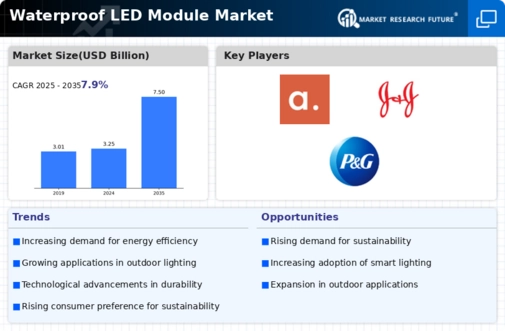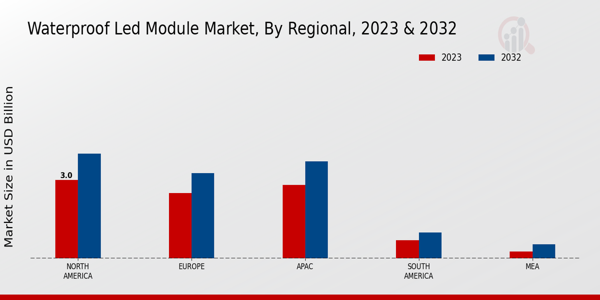Market Growth Projections
The Global Waterproof LED Module Market Industry is projected to experience substantial growth in the coming years. With an estimated market value of 3.25 USD Billion in 2024, the industry is anticipated to expand significantly, reaching 7.5 USD Billion by 2035. This growth trajectory is supported by a compound annual growth rate of 7.9% from 2025 to 2035. Factors contributing to this expansion include rising demand for energy-efficient solutions, increased adoption in outdoor applications, and advancements in LED technology. As the market evolves, stakeholders are likely to explore new opportunities and innovations to capitalize on this growth.
Expansion of Smart City Initiatives
The Global Waterproof LED Module Market Industry is significantly influenced by the expansion of smart city initiatives worldwide. Governments are investing in advanced infrastructure that incorporates smart lighting systems, which often utilize waterproof LED modules for their reliability and longevity. These systems not only enhance public safety but also improve energy management and reduce operational costs. As urban areas continue to grow, the integration of smart technologies is likely to accelerate, with waterproof LED modules playing a crucial role. This trend suggests a promising trajectory for the market, as cities aim to become more sustainable and technologically advanced.
Rising Demand for Energy Efficiency
The Global Waterproof LED Module Market Industry is experiencing a notable increase in demand for energy-efficient lighting solutions. As energy costs continue to rise, consumers and businesses are seeking alternatives that reduce electricity consumption while maintaining high performance. Waterproof LED modules, known for their durability and efficiency, are becoming increasingly popular in various applications, including outdoor lighting and industrial settings. This shift is projected to contribute to the market's growth, with the industry expected to reach 3.25 USD Billion in 2024. The emphasis on sustainability and reduced carbon footprints further drives this trend, indicating a robust future for energy-efficient lighting solutions.
Growing Focus on Environmental Regulations
The Global Waterproof LED Module Market Industry is increasingly shaped by growing focus on environmental regulations and standards. Governments around the world are implementing stricter guidelines aimed at reducing energy consumption and promoting sustainable practices. Waterproof LED modules, which typically consume less energy and have a longer lifespan than traditional lighting solutions, align well with these regulations. As compliance becomes more critical for businesses and municipalities, the demand for environmentally friendly lighting solutions is likely to rise. This regulatory environment is expected to further propel the market, as stakeholders seek to adopt technologies that meet or exceed these standards.
Increased Adoption in Outdoor Applications
The Global Waterproof LED Module Market Industry is witnessing increased adoption of waterproof LED modules in outdoor applications. These modules are particularly suited for environments exposed to moisture, dust, and extreme temperatures, making them ideal for street lighting, architectural illumination, and signage. The durability and performance of waterproof LED modules in harsh conditions are driving their popularity among municipalities and businesses alike. As the market evolves, the demand for reliable outdoor lighting solutions is expected to grow, contributing to the industry's projected expansion to 7.5 USD Billion by 2035. This trend highlights the importance of waterproof technology in enhancing outdoor lighting infrastructure.
Technological Advancements in LED Technology
The Global Waterproof LED Module Market Industry is benefiting from rapid technological advancements in LED technology. Innovations such as improved thermal management, enhanced light output, and longer lifespans are making waterproof LED modules more attractive to consumers. These advancements not only enhance performance but also reduce maintenance costs, further driving adoption across various sectors. As manufacturers continue to invest in research and development, the market is likely to see a surge in new product offerings that meet evolving consumer needs. This technological evolution is expected to support a compound annual growth rate of 7.9% from 2025 to 2035, indicating a vibrant future for the industry.





